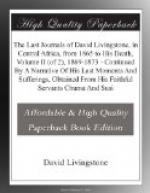In many parts one is struck by the fact of the children having so few games. Life is a serious business, and amusement is derived from imitating the vocations of the parents—hut building, making little gardens, bows and arrows, shields and spears. Elsewhere boys are very ingenious little fellows, and have several games; they also shoot birds with bows, and teach captured linnets to sing. They are expert in making guns and traps for small birds, and in making and using bird-lime. They make play guns of reed, which go off with a trigger and spring, with a cloud of ashes for smoke. Sometimes they make double-barrelled guns of clay, and have cotton-fluff as smoke. The boys shoot locusts with small toy guns very cleverly. A couple of rufous, brown-headed, and dirty speckle-breasted swallows appeared to-day for the first time this season, and lighted on the ground. This is the kind that builds here in houses, and as far south as Shupanga, on the Zambesi, and at Kuraman. Sun-birds visit a mass of spiders’ web to-day; they pick out the young spiders. Nectar is but part of their food. The insects in or at the nectar could not be separated, and hence have been made an essential part of their diet. On closer inspection, however, I see that whilst seeming to pick out young spiders—and they probably do so—they end in detaching the outer coating of spiders’ web from the inner stiff paper web, in order to make a nest between the two. The outer part is a thin coating of loose threads: the inner is tough paper, impervious web, just like that which forms the wasps’ hive, but stronger. The hen brings fine fibres and places them round a hole 1-1/2 inch in diameter, then works herself in between the two webs and brings cotton to line the inside formed by her body.
—What is the atonement of Christ? It is Himself: it is the inherent and everlasting mercy of God made apparent to human eyes and ears. The everlasting love was disclosed by our Lord’s life and death. It showed that God forgives, because He loves to forgive. He works by smiles if possible, if not by frowns; pain is only a means of enforcing love.
If we speak of strength, lo! He is strong. The Almighty; the Over Power; the Mind of the Universe. The heart thrills at the idea of His greatness.
—All the great among men have been remarkable at once for the grasp and minuteness of their knowledge. Great astronomers seem to know every iota of the Knowable. The Great Duke, when at the head of armies, could give all the particulars to be observed in a cavalry charge, and took care to have food ready for all his troops. Men think that greatness consists in lofty indifference to all trivial things. The Grand Llama, sitting in immovable contemplation of nothing, is a good example of what a human mind would regard as majesty; but the Gospels reveal Jesus, the manifestation of the blessed God over all as minute in His care of all. He exercises a vigilance more constant, complete, and comprehensive, every hour and every minute, over each of His people than their utmost selflove could ever attain. His tender love is more exquisite than a mother’s heart can feel.




